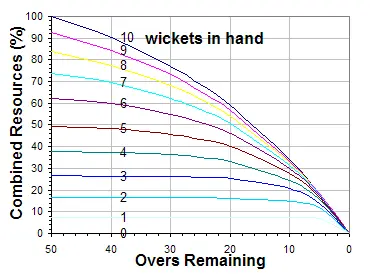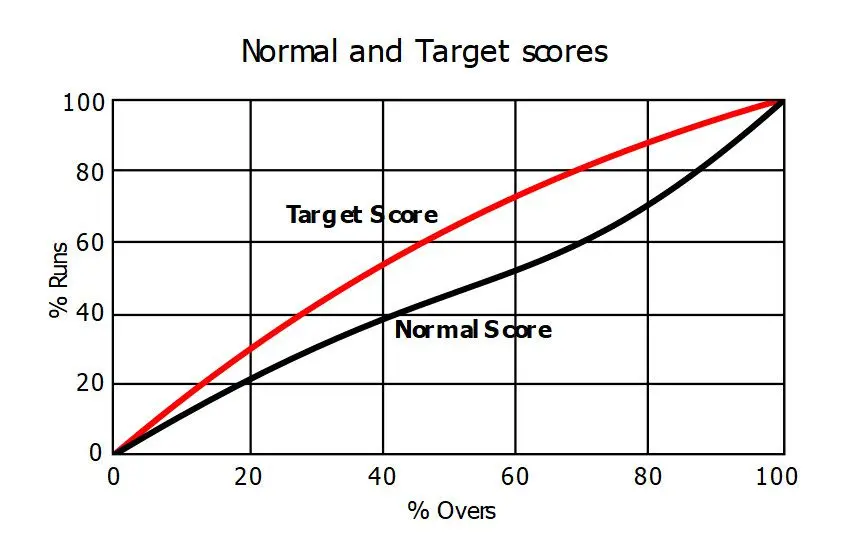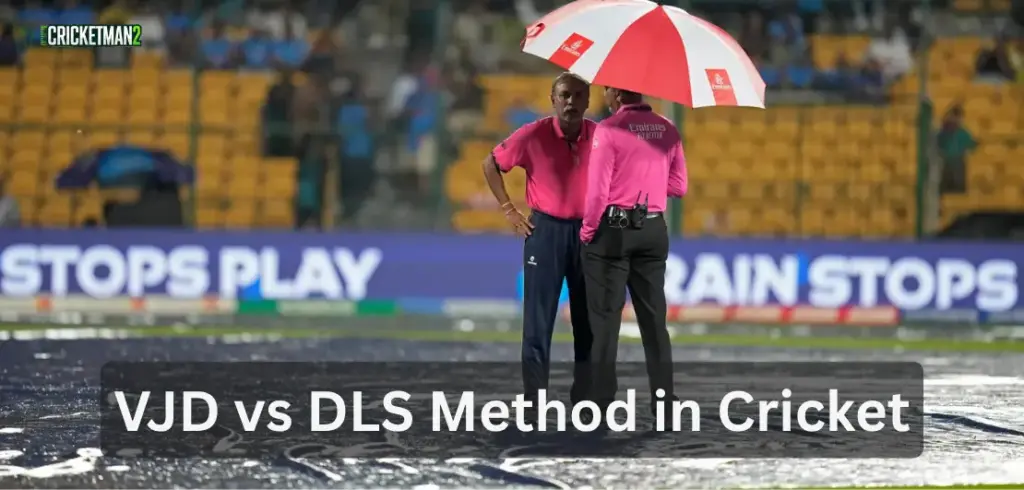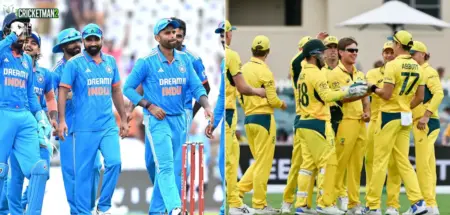Rain interruptions have always been part of cricket’s unpredictable charm — but they often leave fans and players frustrated when matches get shortened or targets become confusing. To maintain fairness, cricket authorities rely on mathematical systems like the Duckworth–Lewis–Stern (DLS) method and India’s very own V. Jayadevan (VJD) method.
While both aim to provide fair revised targets in rain-hit matches, they differ in how they analyze runs, wickets, and match situations. Here’s a complete and simplified breakdown.
What is the DLS Method in Cricket?

The DLS method (Duckworth-Lewis-Stern) was introduced by statisticians Frank Duckworth and Tony Lewis in 1997 and later updated by Steven Stern. It is the official method adopted by the ICC for international matches, including World Cups and T20Is.
How It Works
- The DLS method calculates revised targets based on the overs remaining and wickets in hand.
- It assumes that teams score slowly at first and accelerate in the final overs.
- Using pre-defined resource tables, it adjusts the score to maintain fairness when rain reduces overs.
Example
If Team A scores 250/5 in 50 overs and Team B scores 100/2 in 20 overs before rain stops play, DLS might set a revised target of 82 runs in 20 overs.
Read Also:- Lunch Break Time in Test Cricket: Rules, Impact & Variations Explained
What is the VJD Method in Cricket?

The VJD method was developed by Indian engineer V. Jayadevan from Kerala. It is currently used in BCCI domestic tournaments like the Vijay Hazare Trophy, Syed Mushtaq Ali Trophy, and Maharaja Trophy KSCA T20 League.
Unlike DLS, the VJD method uses two dynamic curves — one for the normal scoring pattern and another for the accelerated phase. This makes it more flexible and, according to many, closer to real match scenarios.
How It Works
- Considers overs played, wickets lost, and run rate trends.
- Divides an innings into three phases — powerplay (acceleration), middle overs (stabilization), and slog overs (rapid scoring).
- Provides different weightage for runs scored at different stages of the game.
Example
For the same scenario (Team A: 250/5 in 50 overs, Team B: 100/2 in 20 overs), the VJD method might set the target as 85 runs in 20 overs — slightly higher than DLS.
Key Differences Between DLS and VJD Methods
| Feature | DLS Method (Duckworth–Lewis–Stern) | VJD Method (V. Jayadevan) |
|---|---|---|
| Invented By | Frank Duckworth, Tony Lewis, Steven Stern | V. Jayadevan (India) |
| Used By | ICC and international cricket | BCCI domestic and state leagues |
| Calculation Basis | Resource percentage (overs & wickets) | Dynamic scoring curves (normal + accelerated) |
| Assumptions | Run rate gradually increases through innings | Run rate peaks in powerplay, dips in middle overs, and rises again at the end |
| Complexity | Very complex mathematical formula | Easier to interpret using phase-wise data |
| Adaptability | Updated regularly but struggles in high-scoring matches | Adapts better to modern scoring rates |
| Implementation | ICC official method | Used in Indian domestic cricket |
| Accuracy in High Totals | Sometimes underestimates or overestimates targets | More balanced for 300+ or 200+ scores |
| Fairness Factor | Gives more importance to wickets remaining | Considers overall scoring pattern and overs equally |
Why ICC Uses DLS and Not VJD
Despite the VJD method being widely praised — even by experts like Sunil Gavaskar — the ICC continues to use DLS for international games. The main reasons are:
- Global Familiarity: DLS has been used worldwide since 1999 and is integrated into ICC software.
- Standardization: All member nations and broadcasters already rely on DLS-based systems.
- Limited Trials: The VJD method, though used successfully in Indian leagues, hasn’t undergone global testing.
- Administrative Inertia: ICC officials prefer continuity over experimentation with newer systems.
However, BCCI’s continued use of VJD in domestic tournaments like the Maharaja Trophy 2024 shows strong faith in its accuracy and fairness.
Read Also:- Tea Break Time in Test Cricket
Mathematical Approach Comparison
| Scenario | Team 1 Score (50 overs) | DLS Target (20 overs) | VJD Target (20 overs) |
|---|---|---|---|
| 200 | 124 | 118 | |
| 250 | 154 | 142 | |
| 300 | 163 | 163 | |
| 350 | 174 | 182 |
Observation: DLS shows smaller increases at higher totals, while VJD maintains a smooth, consistent rise — meaning it better reflects modern high-scoring games.
Recent Usage: VJD in Maharaja Trophy 2024
In the Maharaja Trophy KSCA T20 2024, matches like Hubli Tigers vs Mangalore Dragons and Mysore Warriors vs Shivamogga Lions used the VJD method to decide results after rain. Players like Manish Pandey led their teams to victory using revised targets calculated by VJD, showing its growing reliability in domestic T20 cricket.
Read more: How to Calculate Follow on in Test Cricket: Rules
Expert Opinion
- V. Jayadevan (Inventor):
“The VJD method provides smoother, more realistic targets and avoids sudden jumps that occur in DLS during high scores.” - Critics of DLS:
Say it’s often “sluggish” in high totals and unfairly benefits the chasing team when early overs are lost. - Supporters of DLS:
Argue it’s globally accepted, computer-verified, and statistically proven over thousands of matches.
Conclusion: Which Method is Better?
Both systems have their merits:
- DLS ensures global uniformity and proven track record.
- VJD offers better flexibility, realism, and adaptability to today’s high-scoring formats.
While the ICC remains committed to DLS, many believe it’s time the VJD method gets global recognition — especially as cricket continues to evolve with power-hitting and faster scoring trends.
Read Also:- How to Calculate Follow on in Test Cricket
In Short:
- DLS = Official ICC Method (International Level)
- VJD = Indian Alternative (Domestic Level)
- Verdict: VJD appears more accurate for modern T20 and ODI scoring patterns, but DLS remains the global standard for now.
Author’s Note: The debate between DLS and VJD reflects cricket’s constant evolution — balancing data, fairness, and tradition. As the game grows more dynamic, so should its rain rules.



